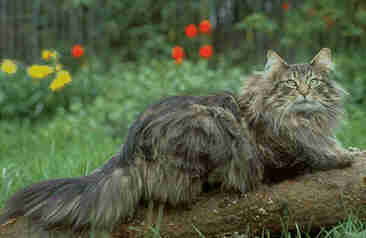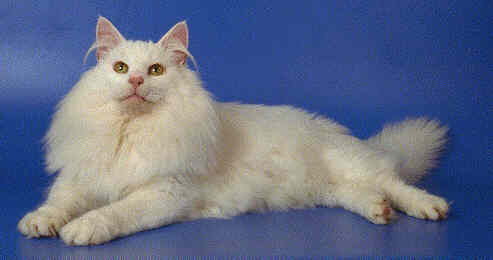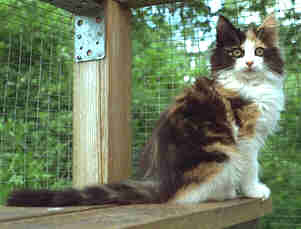What is a Norwegian Forest Cat ?
- a description of the breed by Int. FIFe Judge - Jette Eva Madsen
 |
European
Champion, FIFé World Winner 1991 EC WWA-91 Flatland's Bjørnstierne, DM Norwegian Forest Cat, Male - Brownblotchedtabby |
Most pedigree cat breeds have appeared as the result of cat breeders' ideas of the perfect cat. Breeders have for Generations picked out suitable breeding animals purely to fulfill their picture of the perfect cat. On this fundamental and very important point, the Norwegian Forest Cat differs from most other cat breeds. The forest cat is not a product of planned breeding. It has not been created as the ideal Picture of the perfect cat.
With this point in mind, ones curiosity is aroused and the inevitable question is posed: where does the forest cat come from and why does it have the appearance it has?
- The History
- Description of the Norwegian Forest Cat
- The Spreading of the breed
- The Norwegian Forest Cat at the show-bench
- Frequently Asked Questions
- Recognition
- Author - and where to find more information
The History
In the quest for the forest cat's ancestry, one comes across many more or less fantastic stories.
The oldest folk tales about forest cats are from sources that claim that the household pet cats of the Norwegian Vikings were forest cats. The Vikings took their cats with them on their tours to the known World and beyond, and it is believed that this explains the large numbers of half-wild semi-longhaired cats found in Normandy and perhaps in the USA.
In 1559, the Danish-born priest Peter Clausson Friis, who at that time lived in Norway and was greatly interested in nature, split the Norwegian lynx into three classes: the wolf-lynx, fox-lynx and cat-lynx. Later it became clear that all the Norwegian lynx belonged to the same class. What Peter Clausson Friis called cat-lynx were perhaps really Norwegian Forest Cats. It is quite possible since there actually are many similarities between the lynx and the Norwegian Forest Cat. The more apparent of these are that both are large, high legged cats with a long mane and ear tufts. On top of that, both like water and many are the stories that tell of forest cats with the ability to catch fish in lakes and brooks - just like the lynx.
It has been these similarities between the lynx and the forest cat that have time and time again led people to take a not inconsiderable interest in the forest cats.
In the village there were many cats of course, but in the old folk tales there is especially one type that is mentioned again and again, and it is a large, longhaired cat. Because of the size and its lynx-like characteristics, folk thought that it was a mixture of dog and cat or, more commonly, that it was a half-lynx.
In Asbjornsen and Moes folk tale the forest cat appears several times. Here they are called "Huldrekat" which in the glossary are described as "forest cat with a thick bushy tail". Folk tales and legends are not the only evidence of the frequent natural occurrences of forest cats. The Norwegian author Gabriel Scott wrote in 1912 a very well-read children's book called "Sølvfaks" (Silverfaks). The main character in the book is a forest cat called Solvfaks.
The biological explanation for the occurrence of the forest cat is that their ancestors probably were South European shorthaired cats that had spread to Norway as well as other parts of Europe in prehistoric time, Through the natural selection that has functioned in Norway's different and difficult climatic conditions, only individuals with a thick fur and other adaptations to Norway's harsh climate survived.
In the thirties, Norwegians with an interest in cats began to look at the forest cat. However, it was not until the beginning of the seventies, when it was noticed that the forest cat, as a result of the ruralisation of the Norwegian wilderness and the consequently improved survival chances of shorthaired housecats, was facing extinction, that serious breeding programs were commenced. As is well known, matings between shorthaired and longhaired cats lead to short-haired offspring, so if there are no longer factors like a shortage of suitable warm places that favor longhaired cats then these will soon become extinct.
In December 1975, enthusiastic breeders formed Norsk Skogkattring (Norwegian Forest Cat Club), and already in 1976 the breed was officially accepted by FIFé, the largest international cat organization of Europe.
Description of The Norwegian Forest Cat
 |
Grand
International Champion GIC Norsk Skogkatt Felis Jubatus Norwegian Forest Cat, Male - White |
The hypothesis that the Norwegian Forest Cat has evolved as a result of the natural selection that has worked in Norway's difficult climatic conditions, is based upon the special features one finds in the forest cat. Some of these features of the forest cat are common to other breeds, but no other breed has that unique combination of features that allows it to survive in the Norwegian wilderness.
The most remarkable adaptation is the forest cat's dramatic change of coat. A forest cat develops a thick woolen undercoat during the cool autumn months. The colder it is, or the longer the winter lasts, the thicker and stronger the coat gets. At the same time the fur of the trousers, chest and mane grow.
After the first warm weeks in spring the molting of the undercoat begins and when the temperature reaches 15-20*C, almost all the undercoat is lost within a few days. At this point, the long shining guard hairs are lying close to the cat's Body, and at a distance it is only the tail that indicates that this is a longhaired cat. Even the guard hairs are a chapter of their own. They are long and glistening. Most guard hairs are on the back, down the sides and on the top side of the tail. These guard hairs act completely like a raincoat, and without such an arrangement all wild animals would get pneumonia in a cold and wet climate. This special coat combination with a clear distinction between undercoat and guard hairs is also the reason why the fur never filters outside the molting season and that the forest cat does not need help to look after its fur. Also concerning the fur can be added that the inner sides of the ears are very hairy, and the hair on top of the head and in the front of the ears can reach quite a length, especially during the winter. For a nature cat adapted to a cold climate it is important to reduce heat loss as much as possible.
The forest cat is a large and strong type. If you are at the northern hemisphere, there is a law of biology that says; for the animals of the same breed, the small, thin ones will live towards the south and the large, strong ones towards the north in the area they are found. The reason for this is that the larger animals reduce heat loss since their surface area is less relative to their volume.
Both males and females should have a broad chest and reasonable distance between the shoulders. When the extra large paws are spread out, one should be able to see long toes with strong extra long claws. The legs are long and strong. The advantage of this is that the stomach is not dragged through the snow and thereby cooled. On top of that, the back legs are higher than the front legs, and this explains the characteristic combination of running and long leaps that the forest cat is renowned for. The Body is very muscular and especially the thigh muscles and chest muscles are large and strong. Fully grown (2 to 3 years) forest cats weigh: females 3.8-4.8 kilos; males 5.8-6.8 kilos (7.5-9.5 Ibs and 11.5-13.5 Ibs respectively).
A properly proportioned forest cat head gives the impression of a wild, awake and aware cat. The head form is triangular seen from the front. From the side a long, straight profile line and strong chin is noticeable. The eyes are big, slightly oval and a little angular in placement. The ears are placed such that the outer edge follows a line from the chin past the cheeks to the ears, and the inner edge is placed a little further forward on the head than the outer edge. The ear funnel is vertical. The ear tips have tufts, and the inner edge of the ear has long hair from the base almost to the tip.
The overall impression of a forest cat is a big, muscular, elegant and aware animal.
Also as far as temper and character are concerned the forest cat differs from many other breeds. Regrettably, a description of a breeds temperament and character is often a very stereotyped and boring affair. For some reason or other, all breeds are lively, playful, intelligent and affectionate seen from their owner's point of view. But being a 'nature cat', the Norwegian Forest Cat must be intelligent and inventive to be able to survive. In times of food shortage and bad weather only the intelligent individuals that are able to undertake unorthodox methods in use to obtain food or to keep warm are able to survive.
The forest cat is also very courageous and fearless. As a wild animal, it has for Generations learnt that the best form of defense is attack. Together with its unusually courageous behavior it is a very strong nerved character. The forest cat normally does not become nervous or restless. They take all kinds of change with astounding ease and accustomise to the new conditions.
At the same time it is a very lively, aware and strong cat. Yet there is nothing to prevent you from keeping a forest cat in an apartment, but in such cases it is necessary to have good climbing possibilities like a climbing branch from the floor to the ceiling, to satisfy its natural need for exercise. If it is possible for the cats to go outdoors, they will undoubtedly enjoy climbing the garden's tallest tree. On their way down, one will see them almost run down the tree's trunk and not uncommonly head first. Forest cats, especially females, are tremendous hunters that easily catch healthy, lively birds in flight.
The forest cat thrives together with other cat breeds, dogs and children, but it is perhaps not as decidedly a family cat as the Burmese is reputed to be, since it becomes very attached to one person and follows him/her through thick and thin. It is not unfriendly or uninterested in the rest of the family, as long as it can in quiet moments, in times of trouble, sickness, or at birth, primarily be together with its preferred partner: its owner. If several members of the family wish to have a close relationship with a forest cat, then it is necessary to have a cat each.
As a breeding animal the forest cat is completely healthy and uncomplicated. It appreciates its owner's involvement in its life's highlights like mating and birth, but it can of course handle the situations at ease alone.
The forest cats' well developed intelligence and its energetic and lively behavior places high demands on its owner if the cat is to thrive both physically and mentally, and develop its special abilities fully. The forest cat loves to train through play. It learns easily to walk with a leash, to retrieve, to spring on command and a jot more. If one ensures that it has something to do and that is uses its muscles, the reward is a happy, beautiful and interesting partner.
The spreading of the breed
 |
Karen
Augusta Felis Jubatus Norwegian Forest Cat, Female kitten- Blacktortie/white |
The forest cat has become very popular. What was Norway's national cat in 1976 and only found in Norway, Sweden and Finland, is now a recognized pedigree cat in various feline organizations. At cat exhibitions in Scandinavia and Northern Europe, the forest cat is the best represented semi-longhaired breed, numberwise with 60-180 entered cats. (Exhibitions have, generally speaking, between 300 and 1000 entered cats). The forest cat is now found all over Europe - even in the former eastern block. In USA the breed is having great success and even countries like Argentina and England now have several forest cats.
The Norwegian forest cat's popularity has gone beyond the expectations of the most avid supporters of the breed. Nature has in fact succeeded with such small tools as snow, rain and cold in creating a cat that has attained unusual popularity as a pedigree cat. After having bred forest cats for many years, I believe that the explanation is: the forest cat looks like a "cat", the forest cat is healthy and uncomplicated. the forest cat is big and imposing and last but not least the forest cat has a large coat that does not demand much fur care.
The Norwegian Forest Cat at the show-bench
Starting out with a natural breed of cats in the show world, is a great challenge. As a beginning the general opinion will often be "what does this House Cat do at the show?". But again, the forest cat passed the obstacles without problems. The first step was recognition as a breed, which happened in FIFé in 1976. The next was to take part in the 'Best in Show'-panels.
The last breakthrough towards full recognition as well amongst the international cat judges as in the general public opinion, came with the celebration of the first FIFé World Winners in Wienna 1991. Since 1991 there has been awarded a total of 9 worldwinners within the breed.
The above results speaks for themselves. The Norwegian Forest Cat is a fully accepted member in the 'family' of cat breeds. Worldwide, there are always Norwegian Forest Cats to be found, between the highest awarded cats at the international catshows.
Frequently Asked Questions
"Do they really live in the wild in Norway?"
Yes,- the Norwegian Forest Cat lives as a wild cat in the countryside and forest, in Norway, Sweden and Finland.
"Do they need much grooming?"
No,- the Norwegian Forest Cat is perfectly able to maintain its own coat in beautiful shape. However,- if you want to show a Norwegian Forest Cat, it will need grooming and an occasional bath before the show.
"Can I let my Forest Cat go outdoors?"
The Norwegian Forest Cat is very well adapted to take good care of itself in a natural outdoor environment, even with temperatures well below the freezing point.
"How can I tell a Norwegian Forest Cat from a Maine Coon?"
To the untrained observer, the two breeds look very alike. The Maine Coon tends to be just a bit larger, and the Norwegian Forest Cat has a longer, fuller coat, and a more alert expression. For further details you should compare the actual breeding-standards of the two breeds.
"In what colors do they come?"
The Norwegian Forest Cat come in all colors and tabbypatterns, with and without white. Exceptions are the point patterns; Siamese, Burmese, and the diluted colors; chocolate and lilac.
"Since it is a 'Nature Cat' - how is the temper?"
The Norwegian Forest Cat has no natural enemies, so it is extremely trustful and friendly. Furthermore, as a 'Nature Cat', the Norwegian Forest Cat had the need to develop a high degree of intelligence. This combination makes it the ideal companion and pet for active households.
"Does a Norwegian Forest Cat eat the same as other kind of cats do?"
Yes - the Norwegian Forest Cat thrives well on a normal, well balanced feline diet.
Recognition
The Norwegian Forest Cat is currently recognized in the following feline organizations:
- American Cat Fanciers Association (ACFA)
- The Cat Fanciers' Association (CFA)
- Deutsche Rassekatzen Union (DRU)
- Federation Internationale Féline (FIFe)
- Governing Council of the Cat Fancy (GCCF)
- The International Cat Association (TICA)
- World Cat Federation (WCF)

